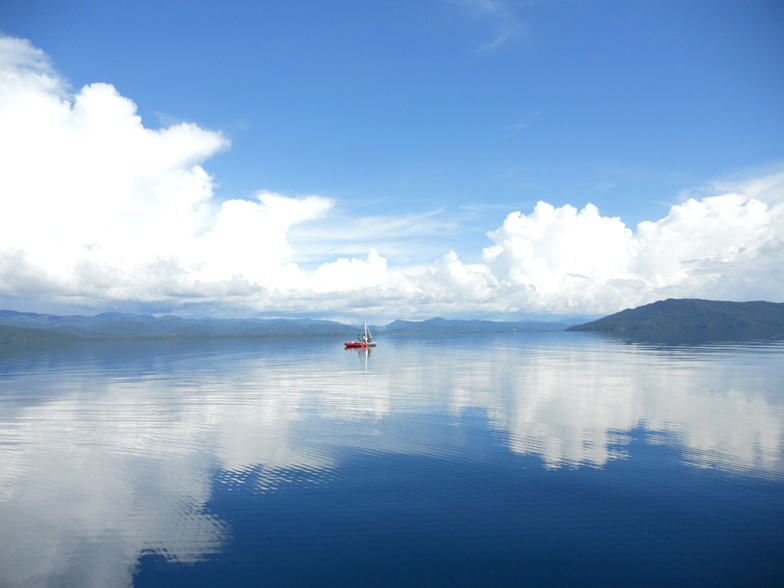Lake Towuti (2.5°S, 121°E) is a, 560 km2, 200-m deep tectonic lake at the downstream end of the Malili lake system, a set of five, ancient (1-2 MYr) tectonic lakes in central Sulawesi, Indonesia. Lake Towuti’s location in central Indonesia provides a unique opportunity to reconstruct long-term paleoclimate change in a crucially important yet understudied region- the tropical Western Pacific Warm Pool (IPWP), centre of the El Niño-Southern Oscillation. The Malili Lakes have extraordinarily high rates of floral and faunal endemism, and the lakes are surrounded by one of the most diverse tropical forests on Earth. Drilling in Lake Towuti will identify the age and origin of the lake and the environmental and climatic context that shaped the evolution of this unique lacustrine and terrestrial ecosystem. The ultramafic (ophiolitic) rocks and lateritic soils surrounding Lake Towuti provide metal substrates that feed a diverse, exotic microbial community, analogous to the microbial ecosystems that operated in the Archean Oceans. The drill cores will provide unique insights into long-term changes in this ecosystem as well as microbial processes operating at depth in the sediment column.

High-resolution seismic reflection data (CHIRP and airgun) combined with numerous long sediment piston cores collected from 2007-2010 demonstrate the potential of Lake Towuti as a valuable archive. Well-stratified sequences of up to 150 m thickness, uninterrupted by unconformities or erosional truncation, are present in multiple sub-basins within Towuti, providing ideal sites for long-term environmental, climatic, evolutionary, and limnological reconstructions. Multiproxy analyses of our piston cores document a continuous and detailed record of moisture balance variations in Lake Towuti during the past 60 kyr BP, highlighted by arid conditions during northern hemisphere stadials and the last glacial maximum, followed by a dry early and wet late Holocene. This history suggests that climate in central Indonesia responds most strongly to high-latitude climate forcing, despite Indonesia’s remote location, and secondarily to southern hemisphere insolation forcing, a hypothesis we aim to test across multiple glacial-interglacial cycles through scientific drilling within the framework of the International Continental Scientific Drilling Program (ICDP). The principal objectives of our TOWUTI initiative are to:
- Document the timing, frequency, and amplitude of orbital- to millennial-scale changes in surface hydrology and terrestrial temperature in the Indo-Pacific Warm Pool across multiple glacial-interglacial cycles
- Understand how variations in terrestrial hydrology and temperature in central Indonesia respond to changes in the mean state of the ENSO system, the monsoons, high-latitude forcing, and insolation
- Analyze the long-term stability and resilience of rainforest vegetation to changes in climate, greenhouse gases, and fire frequency
- Study the extent, biogeography, and metabolism of microbial life in the sediments of a non-sulfidic, ferriginous basin, and their relationships to carbon cycling, redox metal deposition, and the concentration of metal ore minerals
- Study the effects of climate-driven changes in the aquatic environment on both lacustrine microbial populations, and the geobiosphere within the lake’s sediment
- Determine the age of Lake Towuti, and the ensuing rates of speciation of Towuti’s endemic fauna and flora
- Identify the timing of past lake level fluctuations in Towuti, changes in hydrological connections among the Malili Lakes, and how these influenced biological colonization events, habitat stability, and modes of speciation (sympatric, allopatric)
International collaborators (PI’s) within the framework of this project are: J.M. Russell (lead-PI, U. Brown, USA), S. Bijaksana (ITB, Bandung, Indonesia), S.Y. Cahyarini (LIPI, Bandung, Indonesia), D. Fowle (U. Kansas, USA), D. Haffner (GLIER, Canada), Y. Huang (U. Brown, USA), S. Idriyanti (U. Indonesia, Bandung, Indonesia), J. King (U. Rhode Island, USA), A. Noren (U. Minnesota, USA), D. Oppo (WHOI, USA), T. von Rintelen (Museum f. Naturkunde Berlin, Germany), N. Wattrus (U. Minnesota, USA)